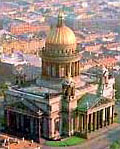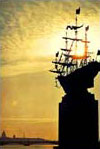
Info about St. Petersburg
 St. Petersburg, the city of white nights, is by far one of the most beautiful cities in the world. After Moscow it is Russia's largest.
Culturally and economically it is the most important city in Russia. On May 16 (May 27, New Style) of the year 1703, after the Russian troops had captured the Nienschantz Fortress (an important strategic point), Peter the Great ordered the construction of the Peter and Paul Fortress on Zayachi Ostrov (Hare Island) in the widest part of the Neva estuary.
This date marks the beginning of the building of a stronghold and a trading port the Baltic coast — St. Petersburg.
St. Petersburg, the city of white nights, is by far one of the most beautiful cities in the world. After Moscow it is Russia's largest.
Culturally and economically it is the most important city in Russia. On May 16 (May 27, New Style) of the year 1703, after the Russian troops had captured the Nienschantz Fortress (an important strategic point), Peter the Great ordered the construction of the Peter and Paul Fortress on Zayachi Ostrov (Hare Island) in the widest part of the Neva estuary.
This date marks the beginning of the building of a stronghold and a trading port the Baltic coast — St. Petersburg.
 With its uniform Baroque and Neoclassical architecture this "Venice of the North", as it is frequently called, is one of the most unique and exquisite cities in Europe.
This historic city sprawls across and around the delta of the Neva River, at the end of the Baltic Sea, known as the Gulf of Finland. The Neva first flows north and then turns west across the middle of the city.
With its uniform Baroque and Neoclassical architecture this "Venice of the North", as it is frequently called, is one of the most unique and exquisite cities in Europe.
This historic city sprawls across and around the delta of the Neva River, at the end of the Baltic Sea, known as the Gulf of Finland. The Neva first flows north and then turns west across the middle of the city.
 The area spreading back from the Winter Palace and the Admiralty on the south bank is truly the heart of the city.
The area spreading back from the Winter Palace and the Admiralty on the south bank is truly the heart of the city.
 The skyline is dominated by the golden dome of St. Isaac's Cathedral.
The main street is called Nevskiy prospect where many of the city's sights, restaurants, and shops can be found.
It is St. Petersburg's main street, stretching for more than four kilometers from the Admiralty like a bowstring across the arc formed by the Neva within the city. This is the busiest thoroughfare, with a history as old as the city itself.
The skyline is dominated by the golden dome of St. Isaac's Cathedral.
The main street is called Nevskiy prospect where many of the city's sights, restaurants, and shops can be found.
It is St. Petersburg's main street, stretching for more than four kilometers from the Admiralty like a bowstring across the arc formed by the Neva within the city. This is the busiest thoroughfare, with a history as old as the city itself.
Rich in culture and tradition, there are numerous things to do and places to see. The following are just a few sites that you may want to visit with that special someone you just met:
 Given the opportunity, a trip to St. Petersburg is an experience that you will not want to pass up.
That, in itself, more than justifies the cost of your tour when you consider the scope and quality of the AFA tour package.
A fascinating cultural experience; however, is merely a delightful byproduct of your tour with A Foreign Affair.
The purpose of your tour is to meet as many of the eligible, beautiful women who inhabit this wonderful city as possible, with the idea of finding that special someone who will permanently enrich your life.
And you will! We can assure you that the decision to stage our Romance Tours in this setting was not whimsical. It followed many months of travel and research.
Ultimately, the decision was amazingly easy. The nature of our tours commands a charming, hospitable and romantic atmosphere with, of course, many, many beautiful women who are sincerely waiting to meet their life mate.
In the C.I.S. countries, this is "St. Petersburg" any way you look at it. We, as well as the lovely women of St. Petersburg, will be eagerly waiting to welcome you there!
Given the opportunity, a trip to St. Petersburg is an experience that you will not want to pass up.
That, in itself, more than justifies the cost of your tour when you consider the scope and quality of the AFA tour package.
A fascinating cultural experience; however, is merely a delightful byproduct of your tour with A Foreign Affair.
The purpose of your tour is to meet as many of the eligible, beautiful women who inhabit this wonderful city as possible, with the idea of finding that special someone who will permanently enrich your life.
And you will! We can assure you that the decision to stage our Romance Tours in this setting was not whimsical. It followed many months of travel and research.
Ultimately, the decision was amazingly easy. The nature of our tours commands a charming, hospitable and romantic atmosphere with, of course, many, many beautiful women who are sincerely waiting to meet their life mate.
In the C.I.S. countries, this is "St. Petersburg" any way you look at it. We, as well as the lovely women of St. Petersburg, will be eagerly waiting to welcome you there!

|
100 Top Adult SitesContact Us |
|
|
||